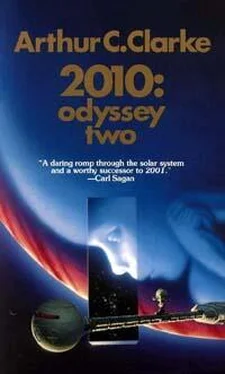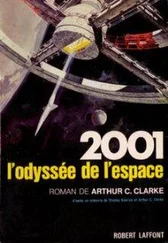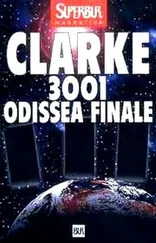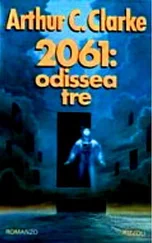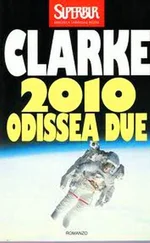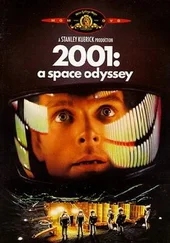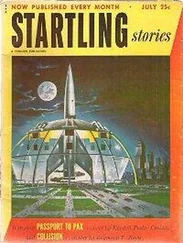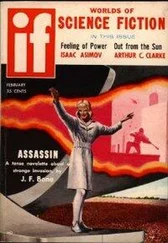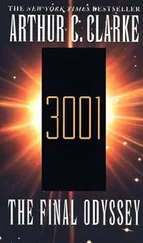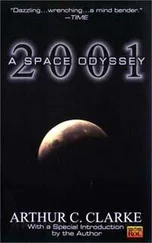Arthur Clarke - 2010 - Odyssey Two
Здесь есть возможность читать онлайн «Arthur Clarke - 2010 - Odyssey Two» весь текст электронной книги совершенно бесплатно (целиком полную версию без сокращений). В некоторых случаях можно слушать аудио, скачать через торрент в формате fb2 и присутствует краткое содержание. Жанр: Фантастика и фэнтези, на английском языке. Описание произведения, (предисловие) а так же отзывы посетителей доступны на портале библиотеки ЛибКат.
- Название:2010: Odyssey Two
- Автор:
- Жанр:
- Год:неизвестен
- ISBN:нет данных
- Рейтинг книги:4 / 5. Голосов: 1
-
Избранное:Добавить в избранное
- Отзывы:
-
Ваша оценка:
- 80
- 1
- 2
- 3
- 4
- 5
2010: Odyssey Two: краткое содержание, описание и аннотация
Предлагаем к чтению аннотацию, описание, краткое содержание или предисловие (зависит от того, что написал сам автор книги «2010: Odyssey Two»). Если вы не нашли необходимую информацию о книге — напишите в комментариях, мы постараемся отыскать её.
2010: Odyssey Two — читать онлайн бесплатно полную книгу (весь текст) целиком
Ниже представлен текст книги, разбитый по страницам. Система сохранения места последней прочитанной страницы, позволяет с удобством читать онлайн бесплатно книгу «2010: Odyssey Two», без необходимости каждый раз заново искать на чём Вы остановились. Поставьте закладку, и сможете в любой момент перейти на страницу, на которой закончили чтение.
Интервал:
Закладка:
Arthur C. Clarke,
2010: ODYSSEY TWO
Author's Note
The novel 2001: A Space Odyssey was written during the years 1964-8 and was published in July 1968, shortly after release of the movie. As I have described in The Lost Worlds of 2001, both projects proceeded simultaneously, with feedback in each direction. Thus I often had the strange experience of revising the manuscript after viewing rushes based upon an earlier version of the story – a stimulating, but rather expensive, way of writing a novel.
As a result, there is a much closer parallel between book and movie than is usually the case, but there are also major differences. In the novel, the destination of the spaceship Discovery was Iapetus (or Japetus), most enigmatic of Saturn's many moons. The Saturnian system was reached via Jupiter: Discovery made a close approach to the giant planet, using its enormous gravitational field to produce a 'slingshot' effect and to accelerate it along the second lap of its journey. Exactly the same manoeuvre was used by the Voyager space probes in 1979, when they made the first detailed reconnaissance of the outer giants.
In the movie, however, Stanley Kubrick wisely avoided confusion by setting the third confrontation between Man and Monolith among the moons of Jupiter. Saturn was dropped from the script entirely, though Douglas Trumbull later used the expertise he had acquired to film the ringed planet in his own production, Silent Running.
No one could have imagined, back in the mid-sixties, that the exploration of the moons of Jupiter lay, not in the next century, but only fifteen years ahead. Nor had anyone dreamed of the wonders that would be found there – although we can be quite certain that the discoveries of the twin Voyagers will one day be surpassed by even more unexpected finds. When 2001 was written, Io, Europa, Ganymede, and Callisto were mere pinpoints of light in even the most powerful telescope; now they are worlds, each unique, and one of them – Io – is the most volcanically active body in the Solar System.
Yet, all things considered, both movie and book stand up quite well in the light of these discoveries, and it is fascinating to compare the Jupiter sequences in the film with the actual movies from the Voyager cameras. But clearly, anything written today has to incorporate the results of the 1979 explorations: the moons of Jupiter are no longer uncharted territory.
And there is another, more subtle, psychological factor to be taken into consideration. 2001 was written in an age that now lies beyond one of the Great Divides in human history; we are sundered from it forever by the moment when Neil Armstrong set foot upon the Moon. The date 20 July 1969 was still half a decade in the future when Stanley Kubrick and I started thinking about the 'proverbial good science-fiction movie' (his phrase). Now history and fiction have become inextricably intertwined.
The Apollo astronauts had already seen the film when they left for the Moon. The crew of Apollo 8, who at Christmas 1968 became the first men ever to set eyes upon the Lunar Farside, told me that they had been tempted to radio back the discovery of a large black monolith: alas, discretion prevailed.
And there were, later, almost uncanny instances of nature imitating art. Strangest of all was the saga of Apollo 13 in 1970.
As a good opening, the Command Module, which houses the crew, had been christened Odyssey, Just before the explosion of the oxygen tank that caused the mission to be aborted, the crew had been playing Richard Strauss's Zarathustra theme, now universally identified with the movie. Immediately after the loss of power, Jack Swigert radioed back to Mission Control: 'Houston, we've had a problem.' The words that Hal used to astronaut Frank Poole on a similar occasion were: 'Sorry to interrupt the festivities, but we have a problem.'
When the report of the Apollo 13 mission was later published, NASA Administrator Tom Paine sent me a copy, and noted under Swigert's words: 'Just as you always said it would be, Arthur.' I still get a very strange feeling when I contemplate this whole series of events – almost, indeed, as if I share a certain responsibility.
Another resonance is less serious, but equally striking. One of the most technically brilliant sequences in the movie was that in which Frank Poole was shown running round and round the circular trick of the giant centrifuge, held in place by the 'artificial gravity' produced by its spin.
Almost a decade later, the crew of the superbly successful Skylab realized that its designers had provided them with a similar geometry; a ring of storage cabinets formed a smooth, circular hand around the space station's interior. Skylab, however, was not spinning, but this did not.deter its ingenious occupants. They discovered that they could run around the track, just like mice in a squirrel cage, to produce a result visually indistinguishable from that shown in 2001. And they televised the whole exercise back to Earth (need I name the accompanying music?) with the comment:
'Stanley Kubrick should see this.' As in due course he did, because I sent him the telecine recording. (I never got it back; Stanley uses a tame Black Hole as a filing system.)
Yet another link between film and reality is the painting by Apollo-Soyuz Commander, Cosmonaut Alexei Leonov, 'Near the Moon'. I first saw it in 1968, when 2001 was presented at the United Nations Conference on the Peaceful Uses of Outer Space. Immediately after the screening, Alexei pointed out to me that his concept (on page 32 of the Leonov-Sokolov book The Stars Are Awaiting Us, Moscow, 1967) shows exactly the same line-up as the movie's opening: the Earth rising beyond the Moon, and the Sun rising beyond them both. His autographed sketch of the painting now hangs on my office wall; for further details see Chapter 12.
Perhaps this is the appropriate point to identify another and less well-known name appearing in these pages, that of Hsue-shen Tsien. In 1936, with the great Theodore von Karman and Frank J. Malina, Dr Tsien founded the Guggenheim Aeronautical Laboratory of the California Institute of Technology (GALCIT) – the direct ancestor of Pasadena's famed Jet Propulsion Laboratory. He was also the first Goddard Professor at Caltech, and contributed greatly to American rocket research through the 1940s. Later, in one of the most disgraceful episodes of the McCarthy period, he was arrested on trumped-up security charges when he wished to return to his native country. For the last two decades, he has been one of the leaders of the Chinese rocket programme.
Finally, there is the strange case of the 'Eye of Japetus' – Chapter 35 of 2001. Here I describe astronaut Bowman's discovery on the Saturnian moon of a curious feather 'a brilliant white oval, about four hundred miles long and two hundred wide... perfectly symmetrical... and so sharp-edged that it almost looked... painted on the face of the little moon.' As he came closer, Bowman convinced himself that 'the bright ellipse set against the dark background of the satellite was a huge empty eye staring at him as he approached...' Later, he noticed 'the tiny black dot at the exact centre', which turns out to be the Monolith (or one of its avatars).
Well, when Voyager 1 transmitted the first photographs of Iapetus, they did indeed disclose a large, clear-cut white oval with a tiny black dot at the centre. Carl Sagan promptly sent me a print from the Jet Propulsion Laboratory with the cryptic annotation 'Thinking of you...' I do not know whether to be relieved or disappointed that Voyager 2 has left the matter still open.
Inevitably, therefore, the story you are about to read is something much more complex than a straightforward sequel to the earlier novel – or the movie. Where these differ, I have followed the screen version; however, I have been more concerned with making this book self-consistent, and as accurate as possible in the light of current knowledge.
Читать дальшеИнтервал:
Закладка:
Похожие книги на «2010: Odyssey Two»
Представляем Вашему вниманию похожие книги на «2010: Odyssey Two» списком для выбора. Мы отобрали схожую по названию и смыслу литературу в надежде предоставить читателям больше вариантов отыскать новые, интересные, ещё непрочитанные произведения.
Обсуждение, отзывы о книге «2010: Odyssey Two» и просто собственные мнения читателей. Оставьте ваши комментарии, напишите, что Вы думаете о произведении, его смысле или главных героях. Укажите что конкретно понравилось, а что нет, и почему Вы так считаете.
